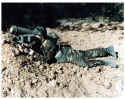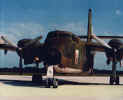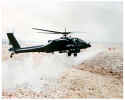1989
FY 89 Dining Facility No. 3 won this year's Phillip A. Connelly Award for the Best Food Service Operation in AMC.
FY 89 Redstone Army Airfield's C-7A Caribou flew 54 hours as part of the relief effort for Hurricane Hugo damage in the Caribbean islands of St. Thomas, St. Croix, Calebra, and Viequez.

FY 89 The 7th Signal Command named the MICOM Records Management Branch (Information Service Command-MICOM) as the Army's best records management program.
FY 89 MICOM's post newspaper, The Redstone Rocket, won the AMC Newspaper and Print Journalist of the Year Award as the top civilian enterprise (CE) newspaper in the tabloid format.
FY 89 Dr. Jay S. Lilley, a research aerospace engineer in the MICOM RD&E Center's Propulsion Directorate, was named the AMC Engineer of the Year.
FY 89 The Electronics & Space Corporation (Emerson Electric Company) received a technical feasibility demonstration contract to show the capabilities and effectiveness of the HELLFIRE missile and launcher electronics development by Rockwell International Corporation for the Swedish Shore Defense System with the ITV.
FY 89 The development effort in support of the German AT2 warhead program was completed during the second quarter.
FY 89 Transition of management responsibility for the BCW program from the MLRS Project Office to the PM for Binary Munitions was completed.
FY 89 The DA decision to phase out REDEYE in FY 94 was pending based on completion of STINGER deployments.
January 89 Civilians employed by the federal government on Redstone Arsenal were now allowed to enroll their children in Redstone Arsenal's Child Development Center. However, military families still had first priority for available slots.
30 January 89 Greek parliamentary approval of the European consortium MOU for the production of the STINGER weapon system occurred. This was the last country to ratify the MOU.
February 89 The 3/43d Air Defense Artillery was the first full PATRIOT battalion.
March 89 A NASA contractor, trenching through an area used in the 1940s for chemical munitions disposal, unearthed 18 World War II-era mortar rounds. Explosive ordnance disposal experts from OMMCS were called to the site, where they found that 4.2-inch chemical rounds and a small fire bomb were in the path of a pipeline excavation near the test stand area west of Dodd Road. Previously, this area was a World War II munitions disposal site reclaimed in the 1950s for rocket and missile test activities. Appropriate permits to transport and store the mortars as hazardous waste were obtained from the Alabama Department of Environmental Management. The mortars were placed individually into steel containers for shipment to Anniston Army Depot, Alabama, then moved in two flights on 29 March.
4 March 89 The Junior Officers Club (JOC) opened. It was housed in the old Youth Services building (114), which had been converted with nonappropriated funds (NAF) into an Officers' Club annex designed to appeal to younger officers.
20 March 89 In a ceremony in Washington, D.C., the Interagency Committee for Women in Science and Engineering (WISE) named Dr. Ann Stanley as the most outstanding woman scientist in the federal government. Dr. Stanley was the branch chief of the quantum physics group in the MICOM RD&E Center's Research Directorate.
30 March 89 The first production PATRIOT stand-off jammer capability (SOJC) missile was fired.
1 April 89 Redstone Army Airfield accomplished a feat only one other airfield Army-wide had managed: the cross training and qualification of its military air traffic personnel in both tower and radar control operations.
26 April 89 Effective this date, MICOM established the Line of Sight Anti-Tank (LOSAT) Project Office (Provisional). At the same time, the mission and associated core personnel for the Kinetic Energy Missile (KEM) program were transferred to the LOSAT PM from the AAWS Project Office.
29 April 89 The 3d Armored Cavalry Regiment was the first unit equipped with AVENGER.
10 May 89 The ground breaking ceremony for a new Enlisted Club was held. Totally funded with NAF dollars, the facility would provide a modern club for soldiers in the lower enlisted grades.
11 May 89 A Product Manager for the HELLFIRE Optimized Missile System (HOMS) was established with responsibility for all activities for the procurement and production of end items and related support equipment. An all-digital, all-ADA software missile that made it easily adaptable to alternate seekers, the HOMS included improvements that enhanced lethality and electro-optical performance in a countermeasure environment.
June 89 Command approval was given to allow federal civilians employed on Redstone Arsenal to use the golf course. Honorary memberships were offered to 40 civic leaders.
June 89 Redstone Arsenal became the Army's first user and South Central Bell's first customer for the Integrated Services Digital Network (ISDN). This was a new automated telecommunications system that enabled users to perform over a single pair of wires several voice and written communications processes at a computer terminal.
June 89 The last Basic MLRS launcher was accepted.
June 89 The LANCE reached the 1000th-missile fired plateau when Federal Republic of Germany troops fired the milestone missile during a flight test at the NATO Missile Flight Installation in Crete, Greece.
21 June 89 The AAWS-M full-scale development contract was awarded to the Joint Venture contracting team of Texas Instruments and Martin Marietta.

July 89 SPC Susan Reed was the first female soldier at Redstone Arsenal to complete the Army Apprenticeship Program, a skills certification recognizing military work experience. Since the program's inception in 1976, only 112 certificates Armywide had been awarded, only 4 of them to women. In addition, Redstone Arsenal soldiers had earned only 15 of those 112 certificates.
July 89 The first STINGER-RMP missiles were delivered.
27 July 89 Delivery of "Deep Attack" M270 launchers began with a roll-out ceremony at the LTV Production Facility in Camden. The "Deep Attack" launchers were capable of firing Army TACMS missiles.
August 89 The New Mexico ARNG completed a successful HAWK firing.
4 August 89 The Officers' Club dedicated its new Regimental Room, which depicted the arsenal's military heritage. Renovated with NAF dollars, an existing meeting room was transformed with displays and state-of-the-art audiovisual aids and telecommunications.
27 August 89 MICOM's WSMD was officially established effective this date, and given the mission of maintaining the readiness of its assigned systems at minimum cost. The systems included HYDRA 70, aerial targets, DRAGON, SHILLELAGH, Land Combat Support System, night sights, HAWK, PERSHING, and CHAPARRAL/FAAR.
27 August 89 The HAWK Project Office transitioned from the operational control of the FAAD PEO to the MICOM WSMD.
27 August 89 The necessary actions to implement matrix management at MICOM were completed at this time.
September 89 The U.S. Senate confirmed MICOM Commander MG August M. Cianciolo for his third star. General Cianciolo, who assumed new duties as DCG for Research, Development, and Acquisition, was succeeded as MICOM Commander by MG William S. Chen on 6 October 89.

September 89 The Army's last C-7A Caribou, which was stationed at Redstone Army Airfield until May 91, was used to assist hurricane relief efforts in San Juan, Puerto Rico, in the aftermath of Hurricane Hugo.

31 October 89 As part of the evaluation of the metal blast panel configuration for the front of the MLRS launcher, 60 MLRS practice rockets were successfully flight tested in consecutive 12-round ripples as quickly as could be executed. The metal blast panel was designed to protect the exposed areas of the M270 launcher from the extremely high velocity gases resulting from rocket motor operation. The new panels would replace the existing neoprene ablative panels that only provided protection from burn-through during firing for 108 rounds. While acceptable in peacetime, this limitation imposed severe restraints in battle. The design goal of providing protection for up to 540 rockets was exceeded during WSMR testing, where 700 rounds were fired with no panel degradation. This effort was later accelerated as part of the MLRS Project Office's support for Operation Desert Shield/Storm (ODS).
November 89 Redstone Army Airfield supported relief efforts for the tornado that hit neighboring Huntsville, Alabama, on this date.
20 December 89 AH-64 APACHES fired seven HELLFIRE missiles during Operation Just Cause in Panama. All were direct hits. This was the first combat use of the HELLFIRE Modular Missile System (HMMS).

Redstone Arsenal Era:
Intro,
1980,
1981,
1982,
1983,
1984,
1985,
1986,
1987,
1988,
1989
